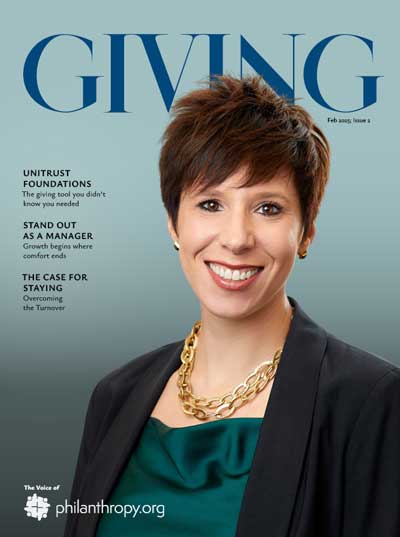When I think about how most of us learned about money, I hear my dad’s voice: “Save first. Live within your means.” I opened my first CD with summer-job earnings sitting next to him at the bank. Later, when I got my first apartment, dad and I built a budget together so I could manage my new earnings and expenses. Those lessons shaped me—and they’re the same lessons my husband and I pass to our two emerging-adult daughters today.
Yet, there’s a third money muscle that many of us never learned to flex: spending.
Personal finance author Ramit Sethi boils money down to three actions: save it, manage it, spend it. We celebrate the first two. The third? We tend to moralize. Spending is framed as risky, even irresponsible.
“All debt is bad.” “Keep cutting.” “Be frugal.”
Those messages seep into our leadership—and into our boardrooms. I see the consequences every day in nonprofit organizations whose leaders can recite their reserves to the penny and whose boards scrutinize expense lines with forensic intensity—but struggle to articulate what they would confidently and proactively spend money on to advance the mission.
It’s not that they’re undisciplined. It’s that they’ve never been taught what healthy, strategic spending looks like.
The Hidden Cost of Irrational Frugality
Despite extraordinary need and ambition in our sector, roughly nine in ten nonprofits in the U.S. operate under $1 million annually; the vast majority (98%) are under $10 million. That’s not an indictment—it’s a signal. In my experience, a key driver is under-investment: organizations trying to “save their way” to growth.
Here’s the pattern. Teams stay stuck raising roughly the same dollars year after year. Annual plans are built on last year plus “a little more.” Leaders keep the appeals, events, and campaigns spinning because it feels safer than spending on the infrastructure that actually scales revenue—talent, systems, training, and time.
When growth stalls, many reorganize the fundraising calendar. But, if the overarching approach to funding the organization is rooted in scarcity—if boards don’t permit strategic spending—rearranging tactics will never create step-change growth.
Reframing Spending as a Mission Tool
Smart spending is not the opposite of stewardship; it is stewardship. It’s how leaders equip their organizations to deliver the mission today and expand it tomorrow. In practice, that means shifting board culture from “guardians of the checkbook” to “investors in the engine.”
Four questions help make the shift:
1) Planning
Are we planning next year based on our strategy and needs—or on what we’ve already committed to financially? Strategic plans without aligned resource plans are wishes.
2) Investing
Are we spending adequately on the real resources required to achieve outcomes—program, administration, and fundraising? Under-resourcing any of the three slows all three.
3) Spending
Do we trust leadership to execute the budget (including a sensible variance) without line-item micromanagement? High-performing organizations accept that some spending precedes revenue.
4) Budgeting
Do we spend at least as much time discussing how we’ll reach the revenue goal as we do debating the expense side? Many boards devote 90% of their budget attention to expenses—starving the conversation that actually generates dollars.
When these are clear, then fundraising tactics begin to work at scale.
What Strategic Spending Looks Like
Let’s start here: people. Hire or upskill a team that can lead investment-level donor conversations—people who can translate program goals into multi-year growth plans, answer financial questions, and confidently invite large, unrestricted gifts.
Then, think about time. Protect executive and development time for relational work (not just campaign production). Step-change gifts rarely happen on a 30-day timeline; they’re the product of 6–18 months of thoughtful engagement.
We can’t forget about systems. Build a clean, accountable moves-management system and financial modeling that links goals to resources, not just to last year’s results.
Finally, story + math. Equip your team with materials that pair outcomes and impact with unit economics, cash-flow realities, and three-year projections. Heart plus head.
None of this is reckless. It’s disciplined. It’s spending on purpose.
Addressing the Boardroom “What-Ifs”
Inevitably, moving from frugality to investment invites pushback. You’re not alone if your first reaction is, “But, what if…”. So, let’s name those pressing concerns so we can deal with them constructively.
“What if we spend and it doesn’t pay off?”
Approach spending as a portfolio. Not every investment returns equally, but the portfolio should return more than it costs over an appropriate horizon. Define success metrics before funding. For example, the number of new investment-level relationships opened, percent unrestricted growth, days cash on hand.
“Debt is unacceptable.”
Some forms of financing (bridge lines, for example) are tools, not moral failings. The real question is whether your financial strategy increases mission capacity and reduces volatility over time. Strategic spending paired with relational fundraising can shorten the duration and frequency of cash gaps.
“We must protect reserves.”
Reserves protect the mission; they aren’t the mission. Hoarding cash while under-resourcing your growth engine is the riskiest strategy of all.
The Board’s Most Powerful Act Isn’t “Doing Fundraising”
If you want to diversify funding or scale by 2x, 3x, even 5x revenue, the most powerful thing a board member can do is champion healthy planning, investing, spending, and budgeting—so leadership can fund the mission fully every year. That’s not a call to profligacy; it’s a call to align money behavior with mission ambition.
Traditional activities still have a place. But, fully funding your organization has far less to do with doubling events or sending more appeals and far more to do with running the organization in a way that empowers your team to generate the dollars you need: consistently, unrestricted, and at scale.
We’ve taught saving and managing well. Now it’s time to teach—and practice—how to spend well, too.







